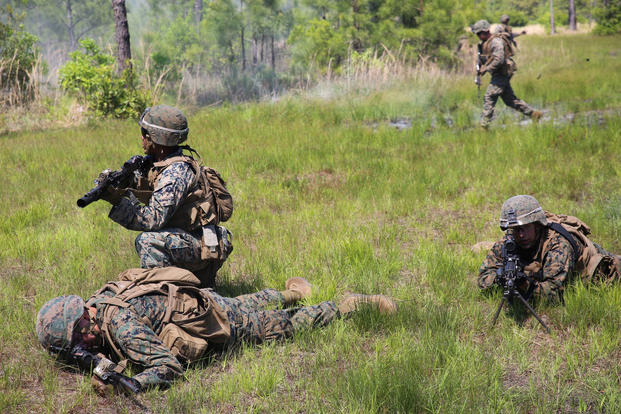Grunts, eat your hearts out.
As the Marine Corps continues to emphasize innovation and experiments with new gear, service officials are getting ready to equip a single infantry squad with an enviable range of equipment, from suppressors to polymer drum mags and special operations-issue hearing protection.
It's part of an 18- to 20-month experiment that Chief Warrant Officer 5 Christian Wade is calling the "Über Squad."
Wade, the gunner, or weapons officer, for 2nd Marine Division out of Camp Lejeune, North Carolina, said the plan is for the 13-person unit to keep all the gear for a full training workup and deployment cycle to somewhere in Europe.
Related content:
- The Marine Corps Is Experimenting With a New Service Rifle
- Marines Move Closer to Making IAR New Infantry Service Rifle
- Corps Will Likely Adopt Army 5.56mm Rifle Round, General Says
The squad will come from Lejeune's 1st Battalion, 6th Marines, though the originating company has yet to be chosen.
The squad is set to be a miniaturized, weapons-focused version of what the Corps is doing with its "experimental battalion," 3rd Battalion, 5th Marines.
Commandant Gen. Robert Neller announced in 2016 that 3/5 would serve as a testing platform for technologies ranging from unmanned aerial vehicles to robots mounted with machine guns, all while remaining an operational infantry battalion.
The unit deployed to the Pacific this spring. As part of its experimental efforts, 3/5 Marines have been equipped with the M27 Infantry Automatic Rifle. The M27 is carried by Marine automatic riflemen, but service officials have discussed the possibility of fielding the weapon as the new service rifle for all or most infantrymen.
Wade has pioneered similar efforts within 2nd Marine Division. He spearheaded an effort last year that put rifle suppressors in the hands of three different companies within 1st Battalion, 2nd Marines, to assess how troops fared using them on deployments around the globe.
For this effort, every Marine in the Über Squad will be equipped with an M27; a suppressor; and Ops-Core helmets used by U.S. Special Operations Command with built-in hearing protection systems that muffle noises loud enough to damage eardrums, while magnifying other sounds to maintain troops' situational awareness.
"This capability protects [Marines'] hearing from high explosives and other loud noises we can't mitigate in combat," Wade said. "But digitally, it allowed you to hear ambient sound."
Experiments to date with suppressors on whole infantry units have shown they work well -- so well that a squad leader might not be able to locate his or her own squad by sound on the other side of a hill.
"Not only do we need hearing protection, we need hearing enhancement," Wade said.
He also plans to fit the section of company-level M240 medium machine guns supporting the squad with suppressors, using equipment borrowed from SOCOM to suppress both barrels of the guns.
Following the kitted-up squad through training and the Corps' traditional pre-deployment event, the integrated training exercise, or ITX, at Twentynine Palms, California, will give Marines the chance to assess the value of the various gear elements and whether they add net cost or value to the warfighter.
Wade said he is looking forward to seeing his Über Squad contend with Range 400, one of the Corps' most dynamic ranges and the only one for which overhead fire is authorized.
"For ... 30 years, I've been running Range 400," he said. "This is the first time I've ever ran it with a maneuver element that is suppressed and a company-level machine gun element that is also suppressed."
As a bonus, Marines in the squad will be equipped with Magpul 60-round polymer drum magazines. Military.com reported back in January that various conventional and special operations units were testing the drum in small quantities as a substitute for traditional 30-round magazines.
While the drums offer a lot of portable firepower, there's also a question of weight to consider. Wade said he planned to set the unit up with about 100 of the drums and let each Marine figure out how many he needed to fight effectively.
"What I think I'm going to find is that, with the ingenuity of the lance corporal, everything is going to find its place," he said. "My assumption is they're ultimately going to be carrying one [drum]."
The effort to equip this squad will take shape over the next month, Wade said.
While the technology the Marines will carry is not new or experimental the way a gun-wielding robot is, it has never been issued to individual Marines at the squad level.
Wade plans to survey Marines at the start and end of the effort about their personal feelings and perceptions carrying the gear, and will couple those observations with objective data showing how the squad stacks up against other units at exercises such as ITX.
"We want to know what the Marines' perception is, do the Marines have confidence in [the gear]," he said.
-- Hope Hodge Seck can be reached at hope.seck@military.com. Follow her on Twitter at@HopeSeck.





























